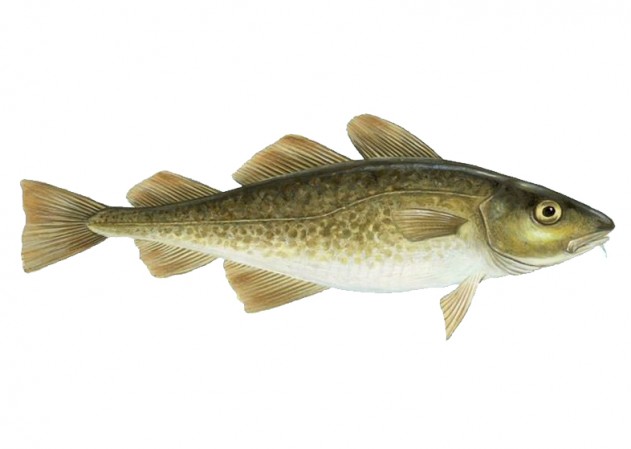Description:
The Atlantic cod have heavy and tapered body, with a prominent chin barbel, a large mouth, projecting upper jaw, and many small teeth. Its snout is rounded on top, and the tail is almost squared. There is a characteristic pale lateral line, 3 dark dorsal fins and 2 dark anal fins, none of which contain any spines. The caudal fin is squared.
Color is highly variable on the back and sides from brownish or sandy to gray, yellow, reddish, greenish, or any combination of these colors), gray white or silvery pale on the underside, and with numerous light spots covering the body.
The Atlantic cod can be distinguished from its relative the pollock by its barbel and projecting upper jaw, and from the haddock by its pale lateral line. It can also be distinguished from the Pacific cod by the less pointed fins. The tomcod is similar, but the caudal fin is rounded; in the Atlantic cod it is squared.
- Dorsal spines: 0; Dorsal soft rays: 44 – 55.
- Anal spines: 0; Anal soft rays: 33 – 45.
- Vertebrae: 51 – 55.
- Lateral line light, curving upward to above the pectoral fin.
- Predorsal distance less than 1/3 of total length.
- Body depth about 1/5 of total length.
- Peritoneum silvery.
- Max length: 2 m, common: 0.6-1 m.
- Max weight: 96 kg, common: 2 to 3 kg.
- Max age: 22-25 years.
Habitats
These fish are widely distributed off the coasts from the shoreline down along the continental shelf in 150 to 200 m. They prefer cool water of 30° to 50°F (0 to 5°C) and may reside in depths over 600 m and in waters as warm as 15°C. Adults are generally found in water over 60 feet deep, whereas juveniles may be found in shallower water; both move deeper during the summer. This is an epibenthic-pelagic species. Cod form schools during the day. Some migrate to warm water in winter to spawn.
They are omnivorous, cod are primarily active, feed at dawn or dusk on invertebrates and fish, including young cod. Many unusual items have been found in the stomachs of adult cod, including an oil can, a rubber doll, finger rings, clothing, and some very rare deep-sea shells that were previously unknown to science; however, their diet is invertebrates and assorted fish. Very young cod feed on copepods and other small crustaceans while at the surface, and, after dropping to the bottom, small worms or shrimp. Cod feed on molluscs, crabs, starfish, squid, and small fish.
Spawning:
The spawning season is during winter and early spring, in December and January off the Mid-Atlantic Bight and from February through April farther north. The transparent eggs hatch, after floating, within 50 days at 32°F, and in 17 days when the surface temperature is 41°F. Cod spawn once a year, in batches. A large female lays up to five million eggs in midocean, a very small number of which survive.

